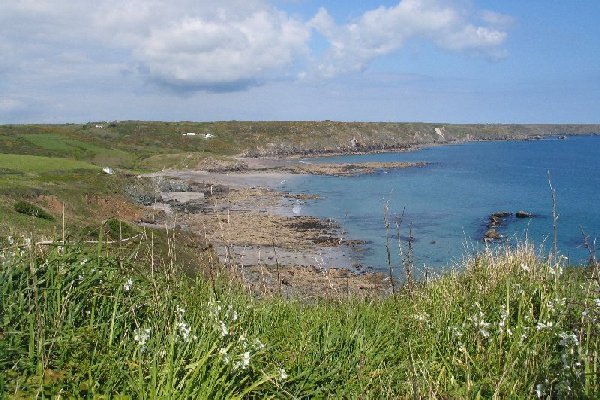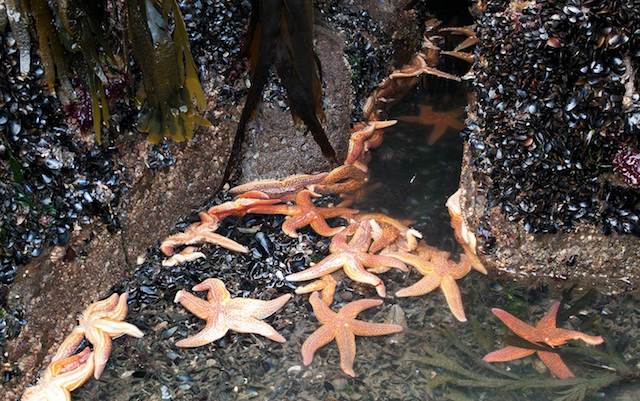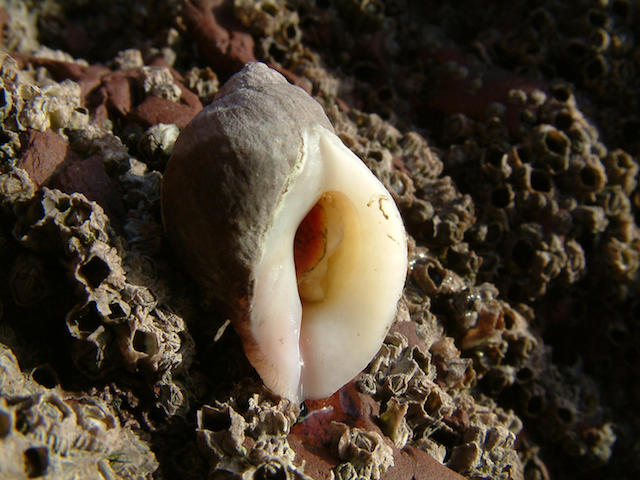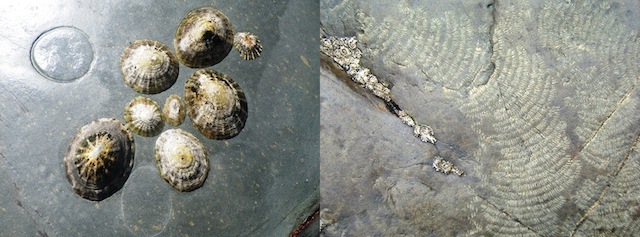In celebration of World Oceans Day (8th June), marine ecologist Caz Waddell delves into the exciting world of rocky shores and uncovers the extraordinary lives of rockpool creatures.
 Kennack Sands. Photo Simon Lewis www.westcountryviews.co.uk
Kennack Sands. Photo Simon Lewis www.westcountryviews.co.uk
Spend some time rockpooling on any shore around the Lizard and you will almost immediately discover a wealth of fascinating plants and animals living between the tides. Barnacles, periwinkles, sponges, prawns, anemones and crabs can all be found in abundance, and the lives of these (and many other) marine creatures are truly extraordinary!
Common starfish eating mussels. Photo John Archer-Thomson
Take the common starfish, Asterias rubens. Starfish have no brain and no blood. They use filtered seawater to pump nutrients through their nervous system. When they find prey they use tiny suction cups (tube feet) to grab hold of their food. They then eat by ejecting their stomachs from their own body, externally digesting their food (typically mussels or clams), and then sucking the partially digested ‘soup’ back into their digestive glands. They can regenerate, but it takes a while; up to a year for a lost limb to grow back.
Beadlet anemone. Photo Matt Slater, Cornwall Wildlife Trust
Another fascinating find is the seemingly innocuous beadlet anemone, Actinia equina. It’s another carnivore, but this time has tentacles covered with stinging cells that paralyze prey items and pass them to the anemone’s mouth (which incidentally is the same opening as their bottom, thank goodness for evolution I say!). Beadlet anemones are surprisingly territorial, ‘nudging’ each other out of the way over a period of days until one is forced to move to a new location.
 Dogwhelk. Photo: Julian Cremona
Dogwhelk. Photo: Julian Cremona
Dogwhelks, Nucella lapillus, are another rocky shore predator; eating barnacles, limpets and mussels. They have a specially adapted tongue called a radula, which is modified for boring through shells, assisted by chemical means. All dogwhelks have a groove in the lip of the shell. This allows water in, to enable the animal to breathe through gills whilst feeding at the same time. This is essential since feeding can take many hours; it can take a dogwhelk 48 hours to devour a barnacle for example, and up to a week to digest larger animals such as mussels. Dogwhelks reproduce by laying hundreds of eggs in small capsules, although only 5-6% of these are fertile. Only the fertile eggs will hatch, and the baby dogwhelk’s first meal is comprised of the infertile eggs in their capsule.
 Limpets (left) and feeding marks left by the radula (right). Photo Caz Waddell
Limpets (left) and feeding marks left by the radula (right). Photo Caz Waddell
Even the limpet has a fascinating story to tell. Limpets are very important herbivores, feeding on microscopic algae covering the rocks. Due to the fact that they graze so efficiently they remove young seaweeds and may prevent the establishment of larger seaweeds like bladderwrack. Limpets feed by scraping their radula across the rock surface. The radula has ‘teeth’ toughened with iron, and this acts like a file. Each sweep removes fine algae and leaves a grazing mark on the rock; you can often see these marks and follow where limpets have been feeding. Limpets are such efficient grazers that sometimes the only remaining algae will be growing on the back of the animal’s shell where it cannot be reached. Others may try to eat it, however in the limpet world it is generally not acceptable to crawl over the back of another individual to get a meal. In fact limpets will rear up (albeit in slow motion) in order to prevent this from happening.
Life between the tides is truly incredible… so why not go and discover it for yourself! Good spots for rockpooling around the Lizard include Kennack Sands, Church Cove, Coverack and a plethora of locations on the Helford. The best place on a shore for making exciting finds is in the pools that become exposed at low tide, though be sure to check a tide timetable so you don’t get cut-off. Try not to walk or splash in the pools; you are more likely to see things if you are still and quiet. Leave animals and seaweeds where you find them, always put overturned rocks back carefully, and only take photos home. Above all, be sure to follow the seashore code and get out there exploring!
Published: June 2016
Author: Caz Waddell (Marine Lead Adviser, Natural England)
Link for seashore code: http://www.wildlifetrusts.org/sites/wt-main.live.drupal.precedenthost.co.uk/files/files/Living Seas/10_Activity_Seashore.pdf
